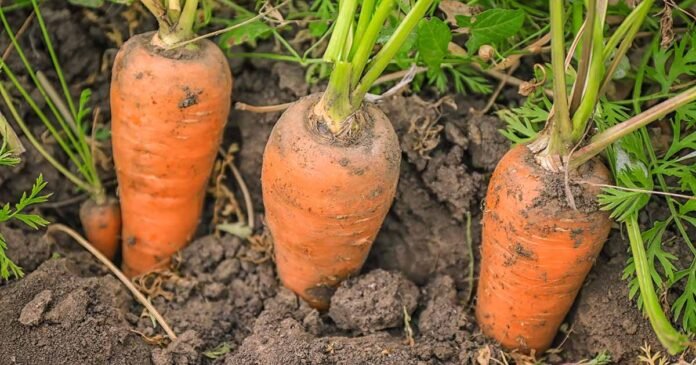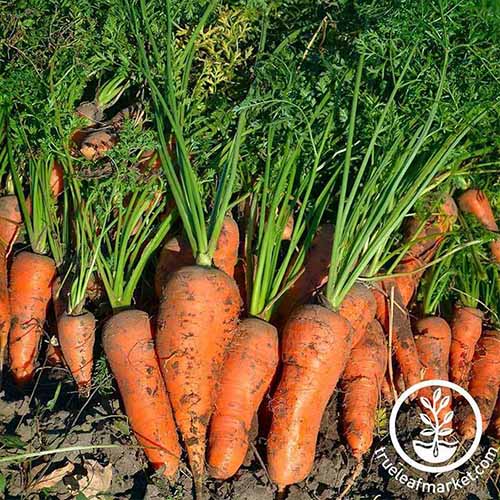Daucus carota sativus ‘Chantenay’
Sometimes a garden presents you with an unexpected reason to rejoice.
Usually that’s a flower – an unanticipated crocus blooming in the snow, or a crape myrtle, presumed dead, sending up fresh growth.
But my personal favorite garden surprise involved vegetables, during the first season I grew ‘Chantenay’ carrots.


We link to vendors to help you find relevant products. If you buy from one of our links, we may earn a commission.
That fall, I was racing home late for the board game night our family was hosting. I fretted that I wouldn’t even have time to get a frozen lasagna in the oven before the guests arrived.
Pulling into the driveway, I noticed a freshly dug spot in one of my container gardens. Entering the house, I heard laughter, and saw young friends happily munching.
In their hands were sunset-hued sticks of carrot, unpeeled, and unadulterated with dip or dressing. My daughter Frances had remembered my little container plot of ‘Chantenay.’
I’ve grown many more of these special gems since then. To this day, they remind me of friendship and offer unexpected rewards from seeds planted long ago.
You might like this variety, too. I’m excited to describe its many advantages, and let you in on all the best ways to grow this carrot that’s red to the core.
Keep reading, and here’s what I’ll cover:
With the botanical classification Daucus carota subsp. sativa, these conical carrots taper to a blunt point.
The original cultivar, ‘Chantenay Red Cored’ comes to us from the Chantenay region of France.
Quick Look
Common name(s): Chantenay carrots
Plant type: Biennial root vegetable
Hardiness (USDA Zone): 3-10
Native to: Eurasia
Bloom time / season: Spring and fall
Exposure: Full sun
Soil type: Sandy, loamy, well-draining
Soil pH: 6.0-6.8, slightly acidic
Time to maturity: 65-70 days
Spacing: 6 seeds per inch when planting, 2 inches after thinning
Planting depth: 1/4 inch (seeds)
Mature size: 1-2 inches wide x 8-18 inches high
Water Needs: Medium
Taxonomy
Order: Apiales
Family: Apiaceae
Genus: Daucus
Species: Carota sativus
Cultivars: Chantenay Red Core, Royal Chantenay
There is debate about when it debuted, but most experts agree it was towards the end of the 1800s. Ferry Morse began selling this variety in 1930.
Crunchy and sweet at maturity, these medium to bright orange roots have smooth, firm skin.
They offer a feast for the eyes when you cut them open, with red cores in sunset hues.
A Minneapolis outfit, Northrup King and Company, released a separate cultivar called ‘Royal Chantenay’ in 1952.
It produces slightly better yields, taller tops, and longer roots, which are five to seven inches at full size.
In its more distant past, like all the root vegetables we know as Daucus carota sativus today, ‘Chantenay’ origins extend back to Eurasia.


This type, like the others produced in the US today, is biennial, with a two-year life cycle.
If no one pulls them up to eat, it’s likely the plants will overwinter and then use that sugar stored in the roots to bloom the following year.
You can browse more options in our guide to the best carrot cultivars. But if this one sounds appealing, let’s get it growing in your garden!
How to Sow
These root vegetables grow just four and a half to six inches long, so you have more places to plant them than you would if you were growing longer varieties like ‘Nantes’ or ‘Imperator.’
They require a soil depth of seven inches or so, not the 10 to 12 inches minimum that others demand.


That means you could plant ‘Chantenay’ in raised beds, even those that are lined with plastic or another material, as long as they’ll have six or seven inches of soil available to set down roots.
These are also a great choice for growing in planters or even indoors.
Ideally, you should sow the seeds in sandy or loamy soil.
They can handle soil that’s a bit on the heavier side, but you’ll risk forked roots and a terrible taste, so it’s better to plant them in soil that drains well.
Also make sure to amend it with plenty of composted organic matter and get rid of any pebbles or other detritus. The roots will go all wonky if they hit resistance in the soil.
Like all carrots, they’ll need a soil pH of 6.0 to 6.8 and full sun to thrive, but they can tolerate part shade.
This is good to know if you’re tucking them into odd spots in an edible container garden or have just a little extra space below one of their good companions, like peas, peppers, or love-in-a-mist.
For the best yields, plant some in a garden spot where they’ll receive at least six hours of sunlight each day.
Only sow the seeds directly in the garden or their final container, instead of trying to start them indoors. The roots really don’t like being disturbed, so transplanting is out!
While I am usually a bit stubborn about the waste involved in sowing too many seeds and then thinning later, in the case of carrots, it’s an absolute necessity. Even ‘Royal Chantenay,’ with its standout yields, often has spotty germination.


Since they take between 14 and 25 days to sprout, you lose several weeks of the growing season if you don’t sow enough and some of them fail to germinate.
I usually sow about six seeds per inch, in rows eight inches apart.
Sow seeds a quarter of an inch deep, covered with a light growing medium like commercial seed-starting mix or a couple of handfuls of loam mixed half and half with vermiculite.
After sowing, water lightly, using the gentle nozzle on the garden hose, or even a clean plastic spray bottle set to “fine mist.”
It’s important to keep that soil moist but not soggy until you see sprouts. If the growing medium becomes dry and forms a crust, the seedlings won’t be able to power through it.
When germination conditions are too soggy, the seeds might rot instead of sprouting, or they may wash away in the next rain.
Next I’ll share some more tips to guide you for the couple of months required between sowing and harvest. Spoiler alert: Thinning is essential, so expect some nagging about that.
How to Grow
After the seeds sprout and the tops grow a couple of inches, your focus will shift from just keeping the top inch or so of soil moist to making sure the plants receive ample water.
These crunchy vegetables are not at all drought tolerant!


Supplement with at least an inch of water per week during the early summer in the absence of rain.
‘Chantenay’ grows best when the temperature stays between 60 and 70°F. Try to only sow seeds when your crop will have plenty of time to mature before temperatures soar above that range in your area.
Consider mulching to help retain moisture and suppress weeds. Carrots don’t grow as well when they have to compete for nutrients or sunlight, particularly in their first few weeks of life.
Even when they’re older, you risk damaging the young roots if you have to pull nearby weeds. It’s more effective to mulch and prevent them from sprouting in the first place.


Apply just an inch or so of mulch between the plants and the rows several times throughout the growing season.
Another absolute must: Thinning. Crowded carrots will produce crooked roots. They may look cute on social media memes, but I find they tend to taste terrible.
When the tops reach two inches tall, thin them to stand an inch apart.
Use scissors or a sharp knife and cut the ones you’re removing at the soil line. You don’t want to pull them up, because you may damage or disturb the seedlings you’re trying to keep in the process.
When the greens reach three or four inches, thin again. This time your aim is two-inch spacing.
If you’re careful, you can uproot the carrots using the tops as a handle on this second go ‘round. At that age, they may have already produced tiny carrots you can eat!
They won’t be as sweet or crunchy as the mature versions, but they’re fun as sort of a preview of the delicious harvest to come.
Turn to our complete guide to growing carrots for more tips on improving the yield and flavor of ‘Chantenay’ and other varieties.
Where to Buy
These carrot seeds are readily available. You’ll want enough of them to succession sow every three weeks until the weather becomes too warm, and again in the late summer for an autumn or early winter harvest.
You can find various sizes from a modest packet to a one-pound sack of ‘Red Cored Chantenay’ seeds available at Eden Brothers.
Find ‘Royal Chantenay’ seeds in a variety of packet sizes available at True Leaf Market.
Pests and Disease
We’ll discuss pests first.
Pests
They may have red cores and sure, they’re sort of short, but ‘Chantenay’ are still carrots – and that means the pests that do the most damage attack at the roots.


Carrot rust flies (Psila rosae), for example, are destructo-demons. They look like small green house flies, only their heads are yellow and they always have red eyes.
They aggressively attack the plants by laying eggs where the crown meets the soil. When their larvae hatch, they tunnel into the roots and turn them red.
You can tell they’ve struck if the leaves begin turning black.
Other pests that strike below the soil include wireworms and carrot weevil larvae.
You may be able to prevent trouble by covering the tops and the surrounding soil with a floating row cover, especially in the first 30 days when the plants are at their weakest.
The cover should bar rust flies, leafhoppers, and flea beetles. And unless you’re trying to encourage seed production in the second season, you can leave the row cover in place except to weed or harvest.
Read more about carrot pest identification and control.
Disease
As for diseases, leaf blight is the most common. It begins on the edges of the leaves, establishing white or yellow spots that become brown and look watery.
You should also watch out for aster yellows disease, which stunts the tops and causes hairy roots.
Pests spread aster yellows as they flit or jump from plant to plant in search of food. Leafhoppers are a prime offender, and the disease they spread can overwinter to hit next year’s veggie bed, too.
Bacterial soft rot, cercospora leaf blight, downy mildew, and powdery mildew round out the list of the most common diseases you may encounter with your crop.
Learn how to identify and control carrot diseases here.
Harvesting
It usually takes about 65 to 70 days for the roots to be ready, but add extra time if you’re growing during chillier fall temperatures.
Look for orange showing above the soil line to determine if they’re wide enough to pull. They should be two to two and a half inches in diameter.


If you can’t see the shoulders, you may have to pull one or two to be able to gauge their size.
Happily, you can eat any that are just a little immature, as a tasty preview of what you can expect.
Be sure to pull carrots the day after it rains, or create your own moist soil by irrigating 24 hours ahead of time. You may need a garden fork to loosen the soil around them, too.
Then it’s just a matter of heave ho, uprooting them one by one.
When you plant them to mature in fall and early winter, it’s also possible to store these vegetables in the ground.
The idea is to protect them from frost and pull only those you need, but also to have them all collected by the time the ground freezes.
If you live in an area where winters are mild, you may be able to keep a supply in the ground until early spring, though the tops will die off.
Do make sure to get them up before they sprout for a second season, though. Once they “bolt” and prepare to flower, the roots won’t taste good at all.
For more details on harvesting ‘Chantenay’ and other carrot cultivars, check out our guide.
Storage
While carrots “bunched” with their tops are quite appealing, leave that approach to the food stylists.
The greens may look pretty, but they’ll sap all the moisture from the roots before you have a chance to eat them.


Before storing, immediately brush off any loose dirt. Then, twist or cut the tops to within an inch of the spot where they meet the root.
Store them unwashed in a cotton produce bag in the fridge. You can use zip-top plastic bags instead, but prick a few air holes in it first with the tines of a fork.
This variety is a good keeper. It will stay fresh at 32 to 40°F and 95 percent relative humidity for six to eight weeks. Ordinarily, you’ll find those conditions in your vegetable crisper.
Preserving
With its rich hues, ‘Chantenay’ is a good choice for preserving. I particularly like the way it looks sliced into thin, colorful coins to dehydrate and add to soup mixes.
Other methods include pickling, fermenting, freezing, or dehydrating.
You can also find a recipe for homemade carrot habanero butter to freeze or water bath can in our guide to growing ‘Danvers’ carrots!
Cooking Ideas
Baby food, juice, coleslaw, stew, cake, muffins – there is a seemingly endless parade of dishes this carrot variety will make more delicious.
They provide the perfect sweet-crisp complement to spicy appetizers like cheesy jalapeno black bean dip. Find the recipe on our sister site, Foodal.


The red core and deep orange flesh also gives you an extra incentive to use this type as an ingredient in spreads, purees, or soups.
In addition to being a bit sweeter than a lot of other varieties, the color is something special.
Shan’t Plant Again Without Chantenay
I’ve become sort of attached to ‘Chantenay,’ sentimental sort that I am.


What about you? Do you have experience with this fairly short, red-cored cultivar? Let us know in the comments section below!
And for more information about growing carrots in your vegetable garden, check out these guides next:





